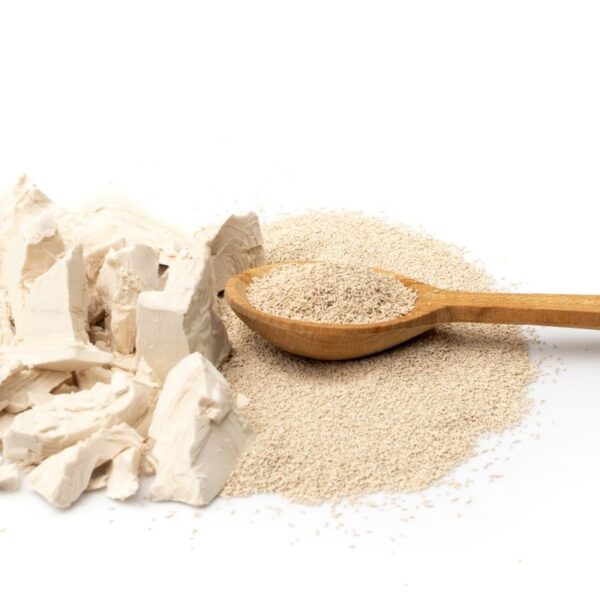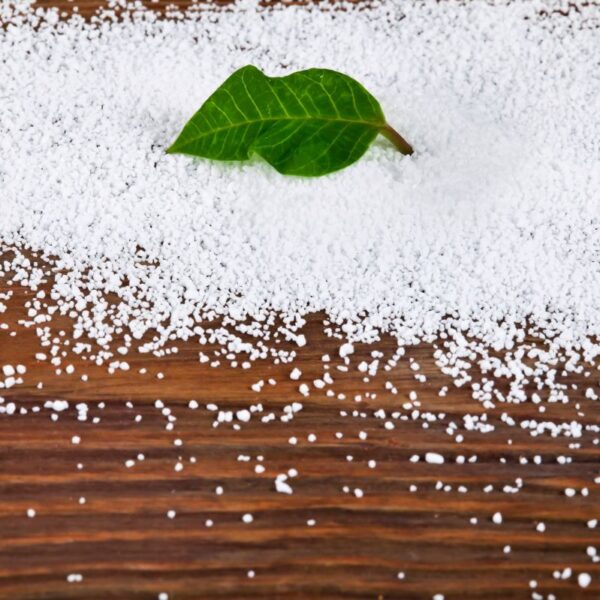Stevia is a plant extract commonly used as an alternative sweetener for people who want to reduce their sugar intake or manage diabetes. It is significantly sweeter than sugar but contains zero calories and has a negligible effect on blood sugar levels.
What is Stevia?
Stevia is derived from the leaves of the Stevia rebaudiana plant, native to South America. Stevia is available in various forms, including liquid extracts, powdered extracts, and granulated blends, and is used to sweeten a wide range of foods and beverages.
Source: NCBI
How is Stevia Produced?
Stevia is produced by extracting sweet compounds from the leaves of the Stevia rebaudiana plant. The leaves are harvested, dried, and steeped in water. This water extract is then filtered to remove impurities and other plant components. The resulting liquid extract is then further processed to isolate sweet compounds known as steviol glycosides. These steviol glycosides are then dried and powdered to create the final stevia product. Some stevia products may undergo additional refining processes to remove residual flavors or aftertaste.
Product Examples
| Type | Examples |
| Bakery | Cake, Cookies, Pastries, Bread |
| Confectionery | Candies, Gums, Soft Chews |
| Chocolate | Chocolate, Compounds |
| Dairy & Dairy Alternates | Ice Cream, Frozen Dessert, Yogurt, Milk-Based Sweets |
| Beverages | Soft Drinks, Milk-Based Drinks, Carbonated Drinks |
| Savory & Culinary | Sauces, Condiments, Curries |
| Convenience | Jams, Jellies, Breakfast Foods |
Special Dietary Usage
| Type | Description |
| Low-Calorie Ciet | Stevia is a non-nutritive sweetener, providing sweetness without adding calories. This makes it an excellent option for individuals looking to reduce calorie consumption and maintain a healthy weight. |
| Diabetic Diet | As a zero calorie sweetener Stevia does not affect blood sugar levels. |
| Keto | Stevia does not contain any carbohydrates, making it a suitable choice for those following a low-carb or keto diet. It does not raise blood sugar levels, so it is safe for individuals with diabetes or those looking to control their blood glucose levels. |
Properties of Stevia
| Physical Form | Powder |
| Color | White |
| Odor | Licorice aroma |
| Shelf Life | 2-3 years |
| Storage Temperature & Conditions | Room temperature |
| Claims (*Product Specific) | Natural*, Halal*, Kosher*, Non-GMO, Organic* |
Typical Formulations
Stevia Sweetener
Here is an example formulation table for stevia sweetener with the composition of ingredients:
| Ingredient | Composition (Parts by Weight) |
| Rebaudioside A (Rebaudioside A: ≧95%) | 100 |
| Sugarcane extract (a) | 1.44 |
| Sugarcane extract (b) | 0.75 |
| γ-aminobutyric acid | 0.25 |
Rebaudioside A is the sweetest and most stable steviol glycoside. The sweetener can be improved further by adding sugarcane-derived extracts and specific auxiliary additives to transglucosylated stevia sweeteners.
Source: Google Patents
High-Fiber Cookies
Here is an example formulation table for high-fiber cookies with the composition of ingredients:
| Ingredient | Composition (Weight) |
| Flour | 500 g |
| Vegetable oil | 60 g |
| Milk | 25 g |
| Egg | 15 g |
| Aerating agent | 5 g |
| Salt | 4 g |
| Soybean fiber | 20 g |
| Steviol glycoside / Rebaudioside A | 0.15 g |
The heat endurance of stevioside and its compatibility with other ingredients makes it suitable to use under various operating conditions, including high-temperature processing. In this formulation, stevioside also reduces soybean dietary fiber’s off-putting smell.
Source: Google Patents
Low-Calorie Carbonated Drink
Here is an example formulation table for a carbonated drink with the composition of ingredients:
| Ingredient | Composition (% Weight) |
| Cola flavor | 0.340 |
| Phosphoric acid | 0.100 |
| Sodium citrate | 0.310 |
| Sodium benzoate | 0.018 |
| Citric acid | 0.018 |
| Stevioside / Rebaudioside A | 0.030 |
| Carbonated water | Make up to 100 |
Source: Google Patents
Sugar-Free Chocolate
Here is an example formulation table for sugar-free chocolate with the composition of ingredients:
| Ingredient | Composition (% Weight) |
| Cocoa liquor | 19 |
| Natural cocoa butter | 32 |
| Rebaudioside D | 0.1 |
| Rebaudioside A | 0.025 |
| Egg albumen powder | 9 |
| Maltodextrin | 10 |
| Soybean phospholipid | 0.6 |
| Vanillin | 0.06 |
| Flavanol | 1 |
| Dietary fiber | 2 |
| Chrysanthemum powder | 10 |
Source: Google Patents
Stevia Formulation Considerations
Sweetness Principles
The leaves of stevia are about 30 times sweeter than sucrose, whereas the compounds called steviol glycosides isolated from the leaves of stevia are 200–300 times sweeter. There are 11 major steviol glycosides, as shown in the table below, of which rebaudioside A and stevioside are the most abundant.
| Sweetener | R1 | R2 | Molecular Formula | Molecular Weight | Sweetness Potency |
| Rebaudioside A | Glcßl- | Glcß(l -2)[G1cß(1-3)]G1cß1- | C44H70O23 | 967.01 | 200 |
| Rebaudioside B | H | Glcß(1-2)[G1cß(1-3)]G1cß1- | C38H60O18 | 804.88 | 150 |
| Rebaudioside C | Glcßl- | Rhaa(1-2)[G1cß(1-3)]G1cß1- | C44H70O22 | 951.01 | 30 |
| Rebaudioside D | Glcß(l -2)G1cß1- | Glcß(1-2)[G1cß(1-3)]G1cß1- | C50H80O28 | 1129.15 | 221 |
| Rebaudioside E | Glcß(l-2)G1cß1- | Glcß(1-2)G1cß1- | C44H70O23 | 967.01 | 174 |
| Rebaudioside F | Glcßl- | Xylß(1-2)[G1cß(1-3)]G1cß1- | C43H68O22 | 936.99 | 200 |
| Stevioside | Glcßl- | Glcß(1-2)G1cß1- | C38H60O18 | 804.88 | 210 |
| Steviolbioside | H | Glcß(1-2)G1cß1- | C32H 50O13 | 642.73 | 90 |
| Rubusoside | Glcßl- | Glcßl- | C32H50O13 | 642.73 | 114 |
| Dulcoside A | Glcßl- | Rhao(1-2)G1cß1- | C38H60O17 | 788.87 | 30 |
Glycosylated Steviol Glycosides
Glucosylated steviol glycosides (GSG) are a mixture of larger glycosides of steviol derived by glucosylation of steviol glycosides extracted from leaves of the Stevia rebaudiana Bertoni plant.
Steviol glycosides have carbohydrate molecules attached to a central steviol (terpenoid) moiety. Naturally occurring steviol glycosides such as stevioside and rebaudioside A can be modified by allowing an alpha-glucosyltransferase to react on an aqueous solution containing one or more steviol glycosides and a glucose donor such as starch or cyclodextrin whereby one or more glucose units are transferred from the glucose donor to the steviol glycoside.
Modified stevoil products can provide an improved sensory experience. For example, in the case of rebaudioside A, the bitterness, aftertaste, and astringency can be decreased.
Sensory Characteristics
Steviol glycosides generally have a slower onset and longer sweetness duration than sugar. Each steviol glycoside has a slightly different flavor. For example, stevioside has a slight herbal taste, rebaudioside-A has a clean taste, and other minor steviol glycosides have a bitter or licorice-like aftertaste. Some people find the lingering sweetness and bitter taste to be less desirable. The composition of the steviol glycoside mixtures may differ according to the cultivar from which the steviol glycosides are extracted and the manufacturing process. The following table provides in-depth information about the sensory properties of stevia.
| Potency | The sweetness potency of rebaudioside A is 200 times that of sucrose at 6% equivalence, whereas rebaudioside M is 310 times that of sucrose. This is similar to the sweetness potency of aspartame. |
| Taste Profile | Stevioside, rebaudioside A, rebaudioside D, and rebaudioside M exhibit clean sweetness at low sucrose equivalence levels. However, they can have negative taste attributes (bitterness, licorice-like taste) at higher sucrose equivalence levels. Stevioside exhibits much more bitterness than rebaudioside A, rebaudioside D, and rebaudioside M. Rebaudioside M also exhibits a sweet, clean taste without any bitter or licorice aftertaste but is present at relatively low levels in currently available stevia plants. |
| Temporal Profile | Among all the steviol glycosides known today, rebaudioside M exhibits the fastest taste onset. |
Source: Springer
Sole Use as a Sweetener
- Stevia provides 200-350 times the sweetness level of sugar.
- Stevia is a zero-calorie sweetener. Totally replacing sucrose or other nutritive sweeteners, such as HFCS, with stevia brings down the calories from added sugar to zero. This significantly reduces total caloric output and helps design equivalently sweet, sugar-free products.
- Stevia weighs significantly less than sucrose, resulting in the loss of bulk, which otherwise would have been provided by sucrose when stevia is used as a replacement. Food products substituting stevia for sugar need other additives to make up the bulk lost.
- At higher concentrations, steviol glycoside-rebaudioside A and stevioside exhibit an off-taste. Major steviol glycosides have been found to provide a significant bitter aftertaste. This is a major downside of using stevia as a sole sweetener in food formulations.
- Stevia does not undergo enzymatic or non-enzymatic browning. It does not caramelize. For this reason, the desired color may not be achieved. On the contrary, stevia exerts antioxidant effects by inhibiting peroxidase and polyphenol oxidase from orange, mango, and papaya to prevent browning.
- Stevia is heat stable (up to 200°C), which means it can be used in cooking and baking without losing its sweetness.
Synergistic Use as a Sweetener
Off-taste can be addressed by blending steviosides with other nutritive and nonnutritive sweeteners. Synergistic use can also improve functional, processing, cost, and stability-related factors.
| Combined with Sugar Alcohols | Stevia can work well synergistically with sugar alcohols, including erythritol, sorbitol, xylitol, and maltitol. Depending on the ratio, these blends may be 2-5x sweeter than table sugar. Sensory properties can also be improved when combining stevia with sugar alcohols, including reducing bitter aftertaste. Sugar alcohols also add some bulk to a formulation. An erythritol/stevia combination is a widely used sweetener blend. |
| Conventional Nutritive Sweeteners | Stevia can partially substitute glucose, fructose, HFCS, inverted sugar, and other conventional nutritive sweeteners in food formulations. Partial substitution allows a partial reduction of the caloric output of food and overcomes the bitter aftertaste from stevia. |
| Combined with High-Potency Sweeteners | The lingering sweetness of steviol glycosides can be masked by adding certain substances with floral and sweet notes. Flavors of coffee, chocolate, spicy sauces, and tea can complement the bitter aftertaste and lingering properties of steviol glycosides. |
| Sensory Combinations | The lingering sweetness of steviol glycosides can be masked by adding certain substances with floral and sweet notes. The bitter aftertaste and lingering properties of steviol glycosides can be complemented by flavors of coffee, chocolate, spicy sauces, and tea. |
Pharmacokinetics
| Absorption | Most of the stevioside consumed is absorbed in the intestine and transported to the liver. |
| Metabolism | The conversion of stevioside and rebaudioside A into steviol occurs in the liver (phase I metabolism). Steviol undergoes enterohepatic reabsorption and is conjugated into steviol glucuronide (phase II metabolism). |
| Excretion | In a study, steviol glucuronide was excreted primarily in the urine during a 72-hour collection period, accounting for 59% and 62% of the rebaudioside A and stevioside doses, respectively. A study of human volunteers showed no detectable amount of stevioside, free steviol, or any other steviol metabolite in the blood after stevioside consumption (750 mg/day); steviol was present in the feces. |
Safety & Regulatory Considerations
| FDA Information | The FDA has evaluated many GRAS notices for the use of high purity (95% minimum purity) steviol glycosides, including Rebaudioside A (also known as Reb A), Stevioside, Rebaudioside D, or steviol glycoside mixture preparations with Rebaudioside A and/or Stevioside as predominant components. However, using stevia leaf and crude stevia extracts is not considered GRAS, and their import into the U.S. is not permitted for use as sweeteners. |
| EU Information | The FDA has evaluated many GRAS notices for the use of high purity (95% minimum purity) steviol glycosides, including Rebaudioside A (also known as Reb A), Stevioside, Rebaudioside D, or steviol glycoside mixture preparations with Rebaudioside A and/or Stevioside as predominant components. However, using stevia leaf and crude stevia extracts is not considered GRAS, and their import into the U.S. is not permitted as sweeteners. |
Health Effects of Stevia
- Diabetes — Stevia can be an alternative sweetener for diabetic patients without affecting blood glucose, HbA1C, insulin, or lipid levels.
- Weight Control — Stevia does not cause weight loss. However, its use as a sweetener in food products reduces the overall caloric value, helping to reduce caloric intake for people trying to lose weight.
- Antioxidant Activity — The antioxidant effect of stevia leaf extract has been ascribed to its radical-scavenging ability, especially its action against superoxide and free radical (unpaired) electrons.
- Anti-Cancer Activity — Besides the cytotoxic effect of purified glycosides, it has been reported that stevia leaf extracts exhibit similar but less potent anti-cancer activity.
- Blood Pressure Regulation — Stevioside may reduce blood pressure and fasting blood glucose. In a study, significant reductions in diastolic blood pressure and fasting blood glucose were observed.
Safety & Toxicity of Stevia
- Toxicity — Stevia glucosides are “generally recognized as safe” by the FDA. However, due to a lack of safety information, whole-leaf stevia and crude stevia extract are not approved for use in processed foods and beverages. Studies have shown that steviol glycosides in stevia are not teratogenic, mutagenic, or carcinogenic and cause no acute and subacute toxicity.
- Allergies — Steviol glycosides are not reactive or metabolized to reactive compounds. For this reason, it is unlikely that steviol glycosides should cause allergic reactions when consumed in foods.
Identification Numbers
| Name | Stevioside |
| CAS Number | 57817-89-7 |
| EC Number | 260-975-5 |
| E Number (Food Additive) | E 960 |
Acceptable Limits or Maximum Usage
The maximum usage level of steviol glycosides in food products per the Codex Alimentarius is as provided here.
The table below lists various stevia ingredients, along with their corresponding FEMA numbers and examples of usage level in common applications:
| Stevia Ingredient | FEMA Number | Usage Level |
| Reb A 60 | 4771 | Most applications < 30ppm, Gum < 200ppm |
| Reb A 80 | 4772 | Most applications < 35ppm, Gum < 234ppm |
| Reb A | 4601 | Most applications < 30ppm, Milk < 45ppm, Cereal < 50ppm, Gum <200ppm, Meat < 75 ppm |
| Reb C | 4720 | Non-alcoholic beverages < 250ppm, Cereal < 400ppm, Gum < 0.1%, Jam < 300ppm |
| Reb D 95 | 4921 | Most applications < 32.5ppm, Gum < 325ppm |
| Reb E 85 | 4936 | Most applications < 45ppm |
| Reb M 80/85 | 4895/4957 | Several applications < 20ppm |
| Reb M 90 | 4968 | Most applications < 35ppm, Baked < 70ppm, Cereal < 100ppm, Milk products < 45ppm |
| Reb M 95 | 4992 | Most applications < 24ppm, Gum < 240ppm |
| Stevioside | 4763 | Beverages < 35ppm, Baked and Candy < 65ppm, Sauces and snacks < 30ppm, Milk products < 55ppm, Gelatins and Puddings < 65ppm |
| Stevioside 70 | 4911 | Most applications < 50ppm, Baked < 200ppm, Cereal < 250ppm |
| Reb B 95 | 4978 | Most applications < 30ppm |
Source: FEMA
Fun Facts About Stevia
- Stevia has been used for centuries by indigenous peoples in South America, particularly in Paraguay and Brazil, as a sweetening agent for their beverages and foods.
- Stevia has been found to have insect-repellent properties. It can deter certain pests, which makes it a potential candidate for natural insect-repellent products.
Additional Sources & Resources
- Springer – Steviol Glycosides: Natural Non-Caloric Sweeteners
- PubMed Central (PMC) – Article PMC4890837
- ScienceDirect – FDA regulatory approach to steviol glycosides
- Nippon Paper Group – Product Information: Steviafin SK Sweet
- PubMed Central (PMC) – Article PMC9223086
- PubMed Central (PMC) – Article PMC6722834














